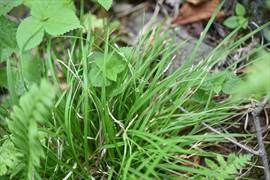Click on images to enlarge

Habitat ⓒ Yanghoon Cho
Scientific Name
Carex xiphium Kom.
Subgeneric Classification (Roalson et al. 2021)
| subgenus Carex; Rhomboidales-Mitrata Clade; Rhomboidales section |
Habitats
Occurs in Gangwon, and it lives in high altitude (approximately 1000m or higher).
Stem
Scattered growth (?) or Clumped growth (?), with basal sheath color light brown, and length about 30-45 cm.
Leaves
Leaves similar to the stem, have glabrous surfaces, width about 6-8 mm.
Inflorescence
The number of spikes two or more. Spike shapes different (showing distinct sexual characteristics), with all spikes unisexual, spikes arranged loosely. Terminal spike sexuality staminate. Lateral spike sexuality pistillate or androgynous, and erect to ascend. Lateral spike length about 1-2 cm. Terminal spike length about 1.5-2 cm. Number of spikes per node one (one spike in one bract).
Bract
Lowermost bract shape thread-like.
Glume
Staminate glume awn absent. Pistillate glume awn short (awn less than one-third of the total length). Pistillate glume color whitish green to light brown.
Perigynium
Transverse section trigonous to terete. Perigynium shape obovate (the broadest part near the apex) (?), elliptical to narrow elliptical (the broadest part in the center) (?) or ovate-lanceolate (the broadest part near the base) (?), and densely flowered (?) or loosely flowered (?). Perigynium glabrous or hairy or pubescent. Beak long (beak more than one-third of the total length), thin (the beak is clearly distinguished from the perigynium, and the starting point of the beak is less than one-third of the widest part of the perigynium) (?) or thick (the beak is not distinguished from the perigynium , and the starting point of the beak is more than one-third of the widest part of the perigynium) (?), with bidentate to bifid mouth. Length 6-7 mm.
Achene
Appendage absent, with constrictions.
Copyright © 2024. All rights reserved.
